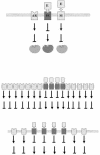Ethylene signal transduction. Moving beyond Arabidopsis
- PMID: 15208412
- PMCID: PMC514102
- DOI: 10.1104/pp.104.040998
Ethylene signal transduction. Moving beyond Arabidopsis
Figures


Similar articles
-
Control of ethylene-mediated processes in tomato at the level of receptors.J Exp Bot. 2002 Oct;53(377):2057-63. doi: 10.1093/jxb/erf062. J Exp Bot. 2002. PMID: 12324529 Review.
-
Evidence that CTR1-mediated ethylene signal transduction in tomato is encoded by a multigene family whose members display distinct regulatory features.Plant Mol Biol. 2004 Feb;54(3):387-404. doi: 10.1023/B:PLAN.0000036371.30528.26. Plant Mol Biol. 2004. PMID: 15284494
-
Ethylene responses are negatively regulated by a receptor gene family in Arabidopsis thaliana.Cell. 1998 Jul 24;94(2):261-71. doi: 10.1016/s0092-8674(00)81425-7. Cell. 1998. PMID: 9695954
-
A dominant mutant receptor from Arabidopsis confers ethylene insensitivity in heterologous plants.Nat Biotechnol. 1997 May;15(5):444-7. doi: 10.1038/nbt0597-444. Nat Biotechnol. 1997. PMID: 9131623
-
Cooperative ethylene receptor signaling.Plant Signal Behav. 2012 Aug;7(8):1009-13. doi: 10.4161/psb.20937. Epub 2012 Jul 25. Plant Signal Behav. 2012. PMID: 22827938 Free PMC article. Review.
Cited by
-
Interaction between QTLs induces an advance in ethylene biosynthesis during melon fruit ripening.Theor Appl Genet. 2013 Jun;126(6):1531-44. doi: 10.1007/s00122-013-2071-3. Epub 2013 Feb 27. Theor Appl Genet. 2013. PMID: 23443139
-
Aminoethoxyvinylglicine and 1-Methylcyclopropene: Effects on Preharvest Drop, Fruit Maturity, Quality, and Associated Gene Expression of 'Honeycrisp' Apples in the US Mid-Atlantic.Plants (Basel). 2024 Sep 8;13(17):2524. doi: 10.3390/plants13172524. Plants (Basel). 2024. PMID: 39274007 Free PMC article.
-
Heterologous microarray experiments allow the identification of the early events associated with potato tuber cold sweetening.BMC Genomics. 2008 Apr 16;9:176. doi: 10.1186/1471-2164-9-176. BMC Genomics. 2008. PMID: 18416834 Free PMC article.
-
NAC transcription factors play an important role in ethylene biosynthesis, reception and signaling of tomato fruit ripening.Mol Genet Genomics. 2016 Jun;291(3):1205-17. doi: 10.1007/s00438-016-1177-0. Epub 2016 Feb 6. Mol Genet Genomics. 2016. PMID: 26852223
-
Dual-level regulation of ACC synthase activity by MPK3/MPK6 cascade and its downstream WRKY transcription factor during ethylene induction in Arabidopsis.PLoS Genet. 2012 Jun;8(6):e1002767. doi: 10.1371/journal.pgen.1002767. Epub 2012 Jun 28. PLoS Genet. 2012. PMID: 22761583 Free PMC article.
References
-
- Abeles FB, Morgan PW, Saltveit ME (1992) Ethylene in Plant Biology, Ed 2. Academic Press, San Diego
-
- Berrocal-Lobo M, Molina A, Solano R (2002) Constitutive expression of ETHYLENE-RESPONSE-FACTOR1 in Arabidopsis confers resistance to several necrotrophic fungi. Plant J 29: 23–32 - PubMed
-
- Bleecker A, Estelle M, Somerville C, Kende H (1988) Insensitivity to ethylene conferred by a dominant mutation in Arabidopsis thaliana. Science 241: 1086–1089 - PubMed
-
- Bleecker A, Kende H (2000) Ethylene: a gaseous signal molecule in plants. Annu Rev Cell Dev Biol 16: 1–18 - PubMed
Publication types
MeSH terms
Substances
LinkOut - more resources
Full Text Sources

